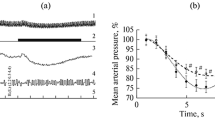Abstract
The magnitude of the local blood flow in the thalamus and cerebral cortex is studied on 22 sexually mature nonpedigree dogs. Mean values of local blood flow are obtained in alert animals, and the effect of narcosis (nitrous oxide) on the local cerebral blood flow is studied. The mean local blood flow in alert dogs is found to be 84.8±2.9 ml/100 g/min in the cerebral cortex and 68.7±1.6 ml/100 g/min in the thalamus. Insignificant fluctuations are found during a dynamic recording of the local blood flow during 7 days. Under narcosis (70% nitrous oxide) the local blood flow decreases 3–12%. According to the findings, nitrous oxide narcosis does not significantly affect the brain circulation, so that it is suitable for an experimental study of the latter.
Similar content being viewed by others
Literature cited
L. S. Andreeva, “Local brain blood flow in the gray and white matter and its variations under conditions of sensitization and brain trauma,” Author's Abstract of Candidate's Dissertation in Medical Science, Moscow (1976).
G. N. Gimmel'farb, Anesthesia in Experimental Animals [in Russian], Fan, Tashkent (1984).
I. T. Demchenko, Blood Supply to the Alert Brain [in Russian], Nauka, Leningrad (1983).
A. -É. A. Kaasik, “Extracellular acidosis of the brain and its pathophysiological significance: an experimental and clinical-biochemical study,” Author's Abstract of Doctoral Thesis, Tartu (1972).
A. V. Meshcheryakov, Anesthesia during Experimental Interventions on Animals. — Handbook of Anesthesiology and Reanimatology [in Russian], Meditsina, Moscow (1982), pp. 251–253.
Yu. E. Moskalenko, Trends in the Development of the Physiology of the Cerebral Circulation, Physiology, Pathophysiology, and Pharmacology of the Cerebral Circulation [in Russian], Synopses Reports First All-Union conf., Erevan (1984), pp. 117–118.
S. I. Teplov, Neurogenic Regulation of the Heart and Brain Circulation [in Russian], Nauka, Leningrad (1980).
V. M. Ugryumov, S. I. Teplov, and G. S. Tigliev, Regulation of the Brain Circulation [in Russian], Leningrad (1984).
G. De Ley, J. Weyne, G. Demeester, and I. Leusen, “Response of local blood flow in the caudate nucleus of the cat to intraventricular administration of carbachol,” Stroke,15, 481–486 (1984).
M. H. Des Rosines, C. Kennedy, C. S. Patlak, K. D. Pettigren, L. Sokoloff, and M. Reivich, “Relationship between local cerebral blood flow and glucose utilization in the rat,” Neurology (Minneapolis.),24, 389 (1984).
R. Kummer, “Local vascular response to change in carbon dioxide tension. Long-term observation in the cat's brain by means of the hydrogen clearance technique,” Stroke,15, 108–114 (1984).
P. Lacombe, P. Meric, and J. Seylaz, “Validity of cerebral blood flow measurements obtained with quantitative tracer technique,” Brain Res. Rev., No. 2, 105–168 (1980).
R. K. S. Lim, C. N. Liu, and R. L. Moffitt, A Stereotactic Atlas of the Dog's Brain, Thomas, Springfield, Ill (1960).
J. D. Michenfelder and R. A. Theye, “Hypothermia: effect on canine brain and whole-body metabolism,” Anesthesiology,29, 1107–1112 (1968).
J. D. Michenfelder and R. A. Theye, “In vivo toxic effects of halothane on canine cerebral metabolic pathways,” Am. J. Physiol.,229, 1050–1055 (1975).
Y. Okada, T. Shima, S. Oki, and T. Uozumi, “Experimental microsurgical embolectomy after middle cerebral artery embolization in the dog,” J. Neurosurg.,58, 259–266 (1983).
H. Seki, T. Yoshimoto, A. Ogawa, and J. Suzuki, “Effect of mannitol on rCBF in canine thalamic ischemia: An experimental study,” Stroke,14, 46–50 (1983).
B. K. Siesjö, Brain Energy Metabolism, Wiley, Chichester-New York (1978).
R. A. Theye and J. D. Michenfelder, “The effect of nitrous oxide on canine cerebral metabolism,” Anesthesiol.,29, 1119–1124 (1968).
D. B. Tower and O. M. Young, “The activities of butyrylcholinesterase and carbonic anhydrase, the rate of anaerobic glycolysis, and the question of a constant denstiy of glial cells in cerebral cortices of various mammalian species from mouse to whale,” J. Neurochem.,20, 269–278 (1973).
Author information
Authors and Affiliations
Additional information
Translated from Fiziologicheskii Zhurnal SSSR imeni I. M. Sechenova, Vol. 73, No. 10, pp. 1321–1324, October, 1987.
Rights and permissions
About this article
Cite this article
Kaasik, A.É.A., Asser, T.K. & Ul'st, M.V. Local blood flow in the thalamus and frontal cortex in alert and narcotized dogs. Neurosci Behav Physiol 18, 384–387 (1988). https://doi.org/10.1007/BF01193883
Received:
Issue Date:
DOI: https://doi.org/10.1007/BF01193883



